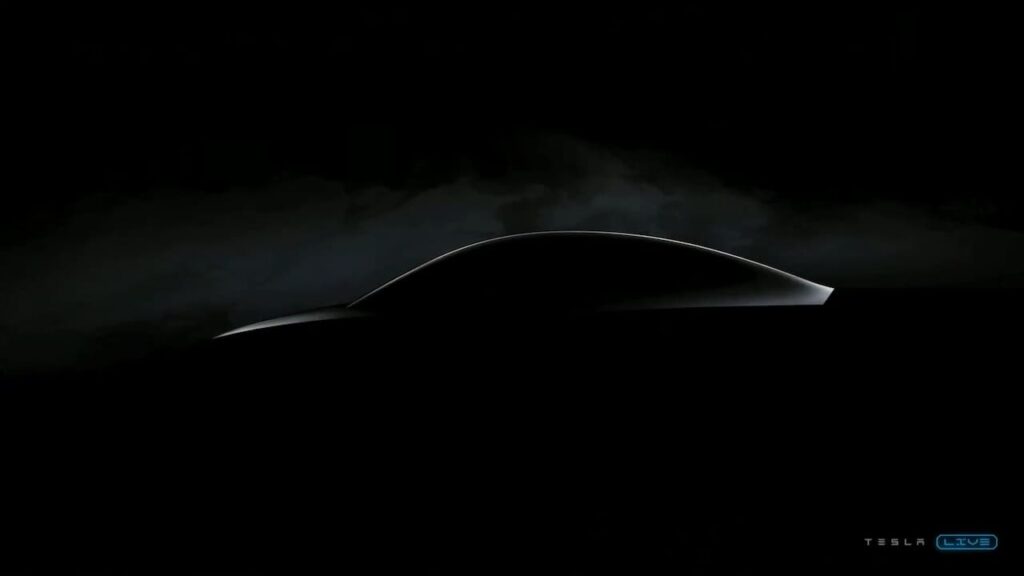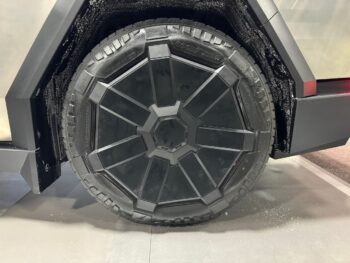Update: Introduction and ‘Tesla Robotaxi’ section updated.
Tesla’s name is synonymous with electric cars, a reputation that has undoubtedly helped it gain nearly 5 million buyers. In fact, Tesla customers are more likely to stick to electric cars when compared to customers using other EV brands, a report by S&P Global said on January 17, 2023. In the third week of September 2023, Tesla built its 5 millionth car, as per an announcement on its X account on the 16th of the month.
Now, let’s take a look at the future Tesla cars that are expected to be launched in the U.S. by mid-decade. Note that the article is a compilation of information from various sources (official and unofficial), and the timelines are speculative.
2024 Tesla Model 3 (refresh)
Unveiled for the European market, and set to debut in the U.S., the 2024 Tesla Model 3 has a refreshed design, new features, and several technical changes. Sporting new horizontal headlights, new wheels, and C-shaped tail lights, the redesigned electric sedan looks sleeker than the outgoing model.

Inside, a new wraparound dashboard, a new steering wheel with scroll and touch-operated buttons, ventilated front seats, an ambient lighting system, an 8-inch rear touchscreen, and a 17-speaker sound system with two subwoofers and two amplifiers are among the main changes. In addition to the new front seats, softer, more refined materials should give occupants added comfort.
Tesla has launched the new Model 3 in Europe in Standard Range RWD and Long Range AWD variants. The 0-62 mph times are the same as the outgoing model – 6.1 seconds (Standard Range RWD)/5.8 seconds (Long Range AWD), but the top speed is much lower – 125 mph. The range figures are slightly higher, though.
The new Model 3 delivers a WLTP range of 344 miles (with 18-inch wheels)/319 miles (with 19-inch wheels) in the Standard Range RWD variant and 389 miles (with 18-inch wheels)/374 miles (with 19-inch wheels) in the Long Range AWD variant. Compared to the outgoing model, these variants offer improvements of 27 miles (with 18-inch wheels)/14 miles (with 19-inch wheels) and 32 miles (with 18-inch wheels)/16 miles (with 19-inch wheels), respectively.
In Germany, the 2024 Model 3 retails at EUR 42,990 (Standard Range RWD)/EUR 51,990 (Long Range AWD). Its U.S. launch should follow in the coming weeks.
Tesla Cybertruck
The radical-looking Tesla Cybertruck was first introduced to the world from the American brand’s design studio in Los Angeles, California, on November 21, 2019.

Where other pickup trucks look similar, the Cybertruck’s styling makes it appear as if it was designed by aliens, Elon Musk’s Twitter post said on July 15, 2021. The Tesla CEO says the Cybertruck is really special and something not witnessed too often, as per Musk’s Twitter post from November 18, 2022.
The Cybertruck is to be offered in single-motor RWD, dual-motor AWD, tri-motor AWD, and quad-motor AWD variants. The latter is also to feature all-wheel-steering, allowing the electric pickup to move “diagonally like a crab,” Elon Musk mentioned in a tweet on December 3, 2021. The Tesla Cybertruck will also get the brand’s popular yoke steering mechanism, von Holzhausen said in the Ride the Lightning podcast.
Tesla Cybertruck deliveries in the U.S. will commence nationwide in September 2023, X user spotted_model said on August 24, 2023. Production of the Tesla truck takes place at the company’s Giga Texas plant in Austin (Texas), USA.
New Tesla Model Y (refresh)
Following the new Model 3 and the Cybertruck, Tesla will likely refresh the Model Y. A report published on March 1, 2023, by Reuters describes the new Tesla Model Y internally as ‘Tesla Juniper,’ and the company plans to begin production in October 2024.
The 2024 Tesla Model Y should feature cosmetic changes, such as new bumpers, reshaped headlamps, and fresh wheels. We expect interior changes to include a new steering wheel with scroll and touch-operated buttons, a new touchscreen infotainment system that can be rotated like that of the new Model S and new Model X, new dashboard trim a fully digital instrument cluster, ventilated front seats, a new, 17-speaker sound system, an 8-inch rear touchscreen, an ambient lighting system, etc.
According to a reliable source within Tesla, the 2024 Model Y is set to have significant changes in specifications, as reported by Tesla Tech Central. The notable updates will reportedly include a new battery architecture that enables a higher range of 400 miles (currently, the maximum EPA-est. range is 330 miles). The vehicle’s suspension is expected to be upgraded for better handling of road imperfections, and an upgraded powertrain is also on the horizon.
Tesla Roadster
The next-gen Tesla Roadster was unveiled to an unsuspecting audience at the company’s Hawthorne facility in California, U.S., on November 17, 2017. The event was initially only to showcase the Tesla Semi, which is why the reveal of the all-electric two-door sports car surprised everyone all over the world.

Speaking to Ryan McCaffrey of Ride the Lightning podcast, Tesla Chief Designer Franz von Holzhausen said that the delay behind the Roadster project has allowed the company to build a far more competitive product, even surpassing Tesla’s initial expectations. While details regarding the two-door sports car’s specifications are scarce, Elon Musk promised that the Roadster will accelerate from 0 to 60 mph in under 2 seconds.
The company has had ideas to boost the maximum torque & RPM figures of the Model S Plaid’s tri-electric motors, Musk said in a tweet on June 13, 2021. Considering what von Holzhausen also said regarding the halo project, it’s possible that the Roadster may arrive with well over 1,020 hp and 1,050 lb.-ft. It’s also expected to have a top speed north of 250 mph, and a dedicated platform with all-wheel drive.
The new Roadster is anticipated to debut in 2024, as mentioned by Musk during the 2023 Annual Shareholder Meeting. Although the CEO expressed hope for production to begin in 2024, he emphasized that it’s not a firm commitment, implying the possibility of further delays in the timeline.
Tesla $25,000 car
The first-ever mention of the USD 25,000 Tesla car was made at the company’s Annual Shareholder Meeting and Battery Day on September 22, 2020. Due to the global Covid-19 pandemic, most attendees were invited for a virtual meeting, with a select few gathering at Tesla’s Fremont facility in California.

Elon Musk admitted that Tesla wasn’t working on a USD 25,000 car when asked by investors at the company’s 2021 annual shareholder meeting. In the meeting, which was uploaded to YouTube on January 27, 2022, Musk mentioned that the brand didn’t have the bandwidth to accommodate an all-new product at the time. However, he said that Tesla would eventually shift focus back onto the project at some point.
On November 3, 2022, the Detroit Bureau reported that the future entry-level EV is back in development months after Musk indicated it had been put on hold. However, the article does not reveal any details about when the project will be completed.
Unofficially known as either the ‘Model C’ or ‘Model Q’, Tesla’s long-term strategy is likely to include more than one model below the 3. To keep costs low, Tesla could move away from traditional Lithium-ion batteries to Lithium Iron Phosphate cells, which are already used on the Model 3.
The $25,000 Tesla car is expected to hit the U.S. market in 2025. Tesla plans to make its most affordable EV at a new Gigafactory in Mexico.
Tesla Robotaxi
Elon Musk announced the plan for the Robotaxi at the Tesla Autonomy Day on April 22, 2019. In the event that was held at the brand’s former headquarters in Palo Alto, California, Musk claimed the Robotaxi would cost “a couple of hundred thousand dollars”.
On September 12, 2023, Simon & Schuster released the Elon Musk biography by bestselling author Walter Isaacson, giving us our first look at a Tesla Robotaxi concept. The model looks like a futuristic show car (see on Electrek) imagined in the early 2000s. It has a wedge-shaped compact body, a notably short hood, a super-sleek glass panel that seems to integrate a low windscreen and the roof, scissor doors, covered front wheels, and concealed rear wheels.
The early Robotaxi prototype is a two-door car with two seats and space for two suitcases in the back. If Tesla is in tune with the market, the driverless taxi should accommodate at least five passengers and a spacious trunk that can store at least five suitcases. Such a car would make for a great airport shuttle, and that’s just one of many potential use cases.
In the 2021 annual shareholder meeting, Musk told investors that the company is expecting autonomous driving technology to become its major source of profitability. According to Tesla’s CEO, robotaxis would be a financially sound plan for the company and all its shareholders. In the Q1 2022 shareholder meeting, (uploaded on YouTube on April 21, 2022) Musk said the company hopes to start production of the Tesla Robotaxi in 2024.
While he didn’t divulge specifics regarding robotaxis, in the podcast with Ryan McCaffrey, Franz von Holzhausen said that Tesla is aware of how customers presently utilize ride-hailing services like Uber and Lyft. He added that the company realizes what customers of such services expect. One of the prime benefits von Holzhausen cited was that of customers being able to focus on tasks unrelated to driving.
Tesla’s Chief Designer also pointed out the relative lack of comfort in the rear seats of these cars, which he believes can be improved. It’s possible that von Holzhausen is hinting at what the Tesla Robotaxi would offer in terms of features, space, and comfort.
The Tesla Robotaxi is expected to release mid-decade.
Tesla Minivan

Elon Musk’s tweet on July 7, 2022, had the CEO hinting at the possibility of a Tesla Minivan in people-carrier and cargo-hauling configurations. When the ‘Tesla Owners Silicon Valley’ handle asked Musk if such a model was indeed likely, Musk replied with a simple wink emoji. Musk also tweeted regarding the electric van’s likelihood of featuring a roof with extendable solar panels, with another tweet stating that the panels could be large enough to offer shade for those under it.
Tesla could equip the electric minivan with its autonomous driving tech and have an interior roomy enough to allow occupants and their luggage to co-exist in harmony. Meanwhile, commercial operators may find the fully-electric van that could, most likely, be charged rapidly using Tesla’s extensive Supercharger network quite handy in their day-to-day operations.
There is no official update on the Tesla minivan, but we expect it to be available in the U.S. market by 2027.
Featured image: TopElectricSUV’s rendering of a restyled Model 3.




